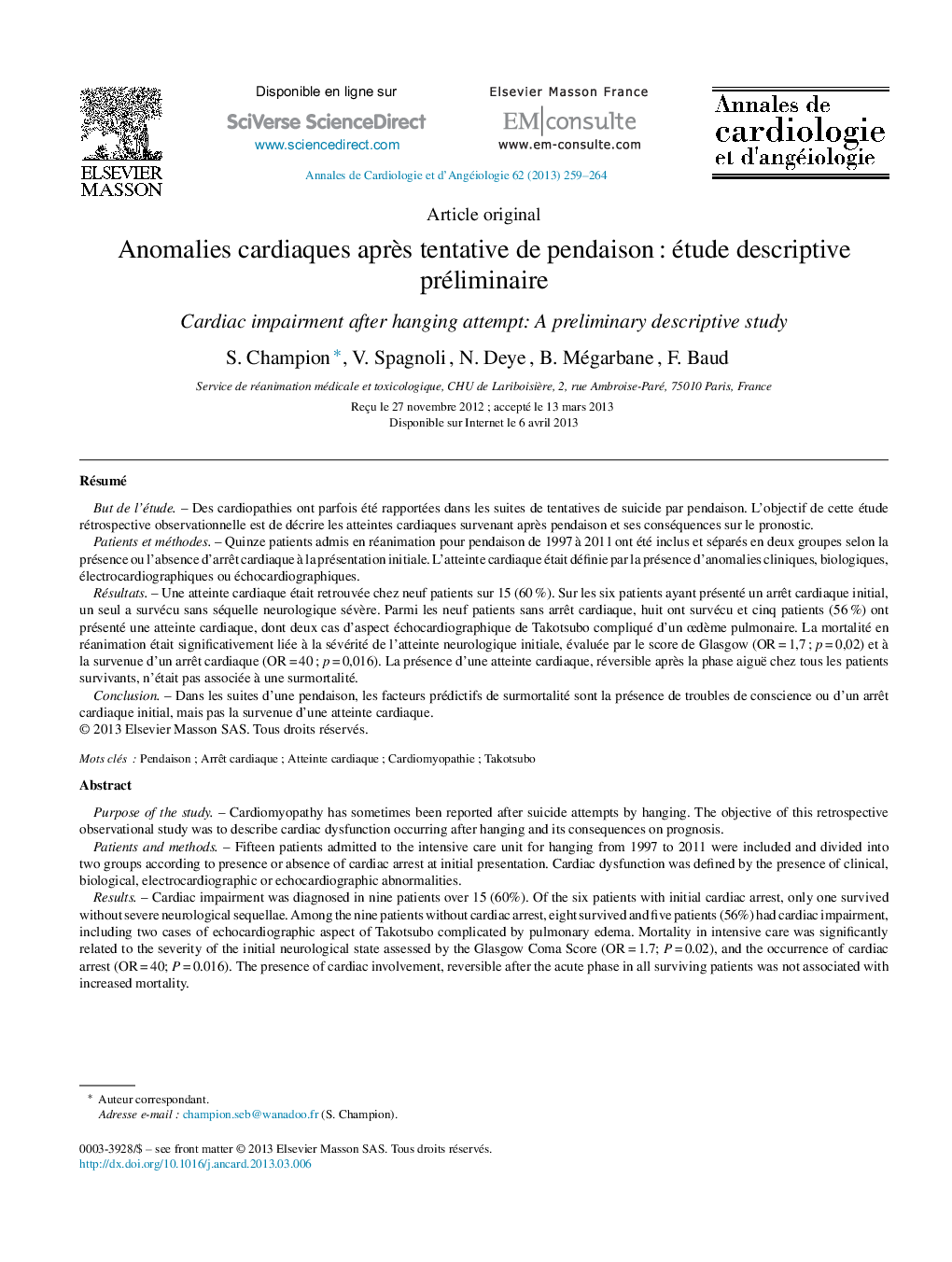| Article ID | Journal | Published Year | Pages | File Type |
|---|---|---|---|---|
| 2868858 | Annales de Cardiologie et d'Angéiologie | 2013 | 6 Pages |
RésuméBut de l’étudeDes cardiopathies ont parfois été rapportées dans les suites de tentatives de suicide par pendaison. L’objectif de cette étude rétrospective observationnelle est de décrire les atteintes cardiaques survenant après pendaison et ses conséquences sur le pronostic.Patients et méthodesQuinze patients admis en réanimation pour pendaison de 1997 à 2011 ont été inclus et séparés en deux groupes selon la présence ou l’absence d’arrêt cardiaque à la présentation initiale. L’atteinte cardiaque était définie par la présence d’anomalies cliniques, biologiques, électrocardiographiques ou échocardiographiques.RésultatsUne atteinte cardiaque était retrouvée chez neuf patients sur 15 (60 %). Sur les six patients ayant présenté un arrêt cardiaque initial, un seul a survécu sans séquelle neurologique sévère. Parmi les neuf patients sans arrêt cardiaque, huit ont survécu et cinq patients (56 %) ont présenté une atteinte cardiaque, dont deux cas d’aspect échocardiographique de Takotsubo compliqué d’un œdème pulmonaire. La mortalité en réanimation était significativement liée à la sévérité de l’atteinte neurologique initiale, évaluée par le score de Glasgow (OR = 1,7 ; p = 0,02) et à la survenue d’un arrêt cardiaque (OR = 40 ; p = 0,016). La présence d’une atteinte cardiaque, réversible après la phase aiguë chez tous les patients survivants, n’était pas associée à une surmortalité.ConclusionDans les suites d’une pendaison, les facteurs prédictifs de surmortalité sont la présence de troubles de conscience ou d’un arrêt cardiaque initial, mais pas la survenue d’une atteinte cardiaque.
Purpose of the studyCardiomyopathy has sometimes been reported after suicide attempts by hanging. The objective of this retrospective observational study was to describe cardiac dysfunction occurring after hanging and its consequences on prognosis.Patients and methodsFifteen patients admitted to the intensive care unit for hanging from 1997 to 2011 were included and divided into two groups according to presence or absence of cardiac arrest at initial presentation. Cardiac dysfunction was defined by the presence of clinical, biological, electrocardiographic or echocardiographic abnormalities.ResultsCardiac impairment was diagnosed in nine patients over 15 (60%). Of the six patients with initial cardiac arrest, only one survived without severe neurological sequellae. Among the nine patients without cardiac arrest, eight survived and five patients (56%) had cardiac impairment, including two cases of echocardiographic aspect of Takotsubo complicated by pulmonary edema. Mortality in intensive care was significantly related to the severity of the initial neurological state assessed by the Glasgow Coma Score (OR = 1.7; P = 0.02), and the occurrence of cardiac arrest (OR = 40; P = 0.016). The presence of cardiac involvement, reversible after the acute phase in all surviving patients was not associated with increased mortality.ConclusionIn the aftermath of hanging, predictors of mortality are the presence of impaired consciousness or initial cardiac arrest, but not the occurrence of cardiac disease.
